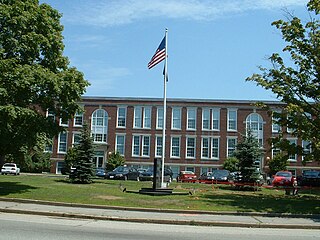
Bristol County is a county in the Commonwealth of Massachusetts. As of the 2020 census, the population was 579,200. The shire town is Taunton. Some governmental functions are performed by the Commonwealth of Massachusetts, others by the county, and others by local towns and cities.

Dartmouth is a coastal town in Bristol County, Massachusetts. Old Dartmouth was the first area of Southeastern Massachusetts to be settled by Europeans, primarily English. Dartmouth is part of New England's farm coast, which consists of a chain of historic coastal villages, vineyards, and farms. June 8, 2014 marked the 350th year of Dartmouth's incorporation as a town. It is also part of the Massachusetts South Coast. The local weekly newspapers are The Dartmouth/Westport Chronicle and Dartmouth Week. The Portuguese municipality of Lagoa is twinned with the town; along with several other Massachusetts and Rhode Island towns and cities around Bristol County.

New Bedford is a city in Bristol County, Massachusetts, United States. It is located on the Acushnet River in what is known as the South Coast region. Up through the 17th century, the area was the territory of the Wampanoag Native American people. English colonists bought the land on which New Bedford would later be built from the Wampanoag in 1652, and the original colonial settlement that would later become the city was founded by English Quakers in the late 17th century. The town of New Bedford itself was officially incorporated in 1787.

The University of Massachusetts is the five-campus public university system and the only public research system in the Commonwealth of Massachusetts. The university system includes five campuses, a satellite campus in Springfield and also 25 campuses throughout California and Washington with the University of Massachusetts Global.

The University of Massachusetts Dartmouth is a public research university in Dartmouth, Massachusetts. It is the southernmost campus of the University of Massachusetts system. Formerly Southeastern Massachusetts University, it was merged into the University of Massachusetts system in 1991.

Down to the Sea in Ships is a 1922 American silent romantic drama film about a 19th-century Massachusetts whaling family. Directed by Elmer Clifton, the film stars William Walcott, Marguerite Courtot, and Clara Bow. The film's title comes from Psalm 107, verses 23–24.

The University of Massachusetts School of Law is a public law school in Dartmouth, Massachusetts. The only public law school in Massachusetts, it is the successor to Southern New England School of Law, a private law school that donated its campus and its assets to the University of Massachusetts Dartmouth. It is accredited by the American Bar Association and part of the University of Massachusetts system.

Padanaram is a coastal village in South Dartmouth, Massachusetts, United States. The village is located on Buzzards Bay, more specifically near the inlet of Apponagansett Bay.
Portuguese Americans, also known as Luso-Americans (luso-americanos), are citizens and residents of the United States who are connected to the country of Portugal by birth, ancestry, or citizenship.

The Trustees of Reservations is a non-profit land conservation and historic preservation organization dedicated to preserving natural and historical places in the Commonwealth of Massachusetts. It is the oldest land conservation nonprofit organization of its kind in the world and has 100,000 member households as of 2021. In addition to land stewardship, the organization is also active in conservation partnerships, community supported agriculture (CSA), environmental and conservation education, community preservation and development, and green building. The Trustees owns title to 120 properties on 27,000 acres (11,000 ha) in Massachusetts, all of which are open to the public. In addition, it holds 393 conservation restrictions to protect an additional 20,000 acres (8,100 ha). Properties include historic mansions, estates, and gardens; woodland preserves; waterfalls; mountain peaks; wetlands and riverways; coastal bluffs, beaches, and barrier islands; farmland and CSA projects; and archaeological sites.

The South Coast of Massachusetts is the region of southeastern Massachusetts consisting of the southern Bristol and Plymouth counties, bordering Buzzards Bay, and includes the cities of Fall River, New Bedford, the southeastern tip of East Taunton and nearby towns. The Rhode Island towns of Tiverton and Little Compton, located in Newport County, are often included within the South Coast designation due to regional similarities with adjacent communities.
Southern New England School of Law (SNESL) was a non-profit law school located in North Dartmouth, Massachusetts that operated from 1981 to 2010. At its closure, its assets were donated to the University of Massachusetts system to become the basis for the University of Massachusetts School of Law.

The Swain School of Design(1881–1988) was an independent tuition-free non-profit school of higher learning in New Bedford, Massachusetts. It first defined its mission as a "school of design" for the "application of art to the industries" in 1902, making it the 12th oldest art school in the United States. By then, the 19th-century whaling capital of the world was already in a textile boom, one that required designers. In response, Swain's trustees developed a meticulous program of study. In the first year, students would train for 40 hours a week in "Pure Design" to prepare them for a second year in "Historic Design." Applied skills spanned a panoply of techniques, involving the design of picture frames, book and magazine covers, illuminations, lettering, stained glass, metalwork, architectural moldings and the "application of ornament to prints." Within a generation, that foresight had made New Bedford, with nearly 70 mills and 41,000 mill workers, the richest city per capita in the U.S.
Richard Albert Canfield was a prominent American businessman and art collector involved in illegal gambling throughout the northeastern United States during the late 19th and early 20th century. Known as the "Prince of Gamblers", Canfield was one of the earliest to develop the modern day "resort casino". The solitaire game Canfield is named in his honor.

The Russells Mills Village Historic District is a historic district on Russells Mills, Rock O' Dundee, Slades Corner, Horseneck and Fisher Roads in Dartmouth, Massachusetts. It encompasses an area that was an early industrial center, flourishing from the 18th century into the early 19th century. The district was added to the National Register of Historic Places in 1985.

The Waterfront Historic Area LeaguE, also known as WHALE, is a non-profit historic preservation organization located in New Bedford, Massachusetts. Its mission is: "to promote the value and reuse of greater New Bedford's historic structures through preservation, education and advocacy". The organization often promotes its cause with the words of one of its founders, Sarah Delano. Delano said, "if you bulldoze your heritage, you become just anywhere".

Grey's raid was a series of raids carried out in Massachusetts by British forces under the command of Major-General Charles Grey in September 1778 during the American Revolutionary War. Grey, leading 4,000 troops, raided the towns of New Bedford and Fairhaven along with Martha's Vineyard as part of the northern theater of the American Revolutionary War after Saratoga. The raids were one of the first in a series of attacks executed by the British against American coastal communities.

The UMass Dartmouth Corsairs football team represents the University of Massachusetts Dartmouth in college football at the NCAA Division III level. The Corsairs are members of the Massachusetts State Collegiate Athletic Conference (MASCAC), fielding its team in the MASCAC since 2013. The Corsairs play their home games at Cressy Field in Dartmouth, Massachusetts.

Delta Kappa Phi (ΔΚΦ) is an American professional–social collegiate fraternity established in 1899. As of 2017 it has one active chapter.

The Southworth Library was a library located in the village of Padanaram, a coastal village located in Dartmouth, Massachusetts, at 404 Elm Street. The library was opened in 1890, and is currently known as the Dartmouth Cultural Center.

















